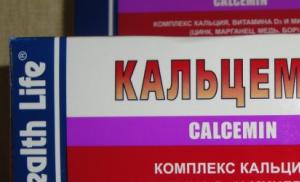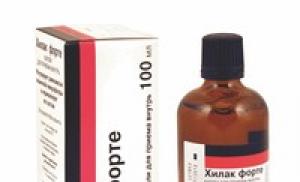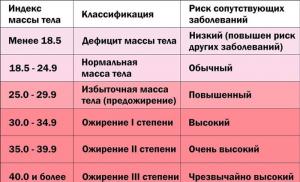Instructions for use of calcemin. Calcemin ® Calcemin how many tablets are in a package

Combined drug. Regulates phosphorus-calcium metabolism.
Drug: CALCEMIN
Active substance of the drug:
comb. drug
ATX encoding: A12AX
KFG: A drug that affects phosphorus-calcium metabolism
Registration number: P No. 015890/01
Registration date: 08/12/04
Owner reg. Credit: SAGMEL, Inc. (USA)
Calcemin release form, drug packaging and composition.
White coated tablets, elongated capsule-shaped, with a notch pressed on one side.
Film-coated tablets
1 tab.
colecalciferol (vit. D3)
50 IU
calcium (in the form of citrate and carbonate)
250 mg
copper (in oxide form)
500 mcg
zinc (in oxide form)
2 mg
manganese (as sulfate)
500 mcg
boron (as sodium borate)
50 mcg
Excipients: maltodextrin, microcrystalline cellulose, croscarmellose sodium, acacia, stearic acid, soy polysaccharide, magnesium stearate.
Shell composition: hydroxypropyl methylcellulose (hypromellose), magnesium silicate, titanium dioxide, sodium lauryl sulfate, silicon dioxide, polyethylene glycol, mineral oil.
30 pcs. — polyethylene bottles (1) — cardboard packs.
60 pcs. — polyethylene bottles (1) — cardboard packs.
120 pcs. — polyethylene bottles (1) — cardboard packs.
The description of the drug is based on the officially approved instructions for use.
Pharmacological action Calcemin
Combined drug. Regulates phosphorus-calcium metabolism. Replenishes the deficiency of microelements, calcium and vitamin D3, helps strengthen bones and joints, and prevents diseases of the musculoskeletal system.
Pharmacokinetics of the drug.
Data on the pharmacokinetics of the drug Kalcemin are not provided.
Indications for use:
Prevention and treatment (as part of complex therapy) of osteoporosis of various origins;
Replenishment of calcium and microelements deficiency in adolescents;
Replenishment of calcium and microelements deficiency in women during pregnancy and breastfeeding.
Dosage and method of administration of the drug.
Adults and children over 12 years of age are prescribed 1 tablet. 2 times/day during meals.
Children aged 5 to 12 years are prescribed 1 tablet. 1 time/day during meals.
During pregnancy and during breastfeeding, the drug is prescribed from the 20th week of pregnancy and throughout the entire period of breastfeeding, 1 tablet. 2 times/day.
For calcium and microelements deficiency, 1 tablet/day is prescribed.
Side effects of Calcemin:
Rarely: nausea, vomiting, flatulence, hypercalcemia, hypercalciuria, allergic reactions.
Contraindications to the drug:
Urolithiasis disease;
Hypercalcemia;
Hypercalciuria;
Hypersensitivity to the components of the drug.
Use during pregnancy and lactation.
It is possible to prescribe the drug Kalcemin during pregnancy and lactation according to indications.
When used during breastfeeding, it should be taken into account that colecalciferol and its metabolites are excreted in breast milk.
Special instructions for the use of Calcemin.
When using the drug, you should not exceed the recommended dose, because Increased calcium intake may inhibit intestinal absorption of iron, zinc and other essential minerals.
Drug overdose:
Symptoms: constipation, nausea, vomiting; It is also possible to develop hypercalcemia and hypercalciuria, leading to the accumulation of calcium in soft tissues and irreversible changes in the kidneys and cardiovascular system.
Interaction of Calcemin with other drugs.
Drug interactions with Kalcemin have not been described.
Terms of sale in pharmacies.
The drug is approved for use as a means of OTC.
Terms of storage conditions for the drug Kalcemin.
The drug should be stored in a dry place, out of reach of children, at a temperature of 15° to 30°C. Shelf life – 3 years.
Calcemin is a vitamin and mineral complex used for the prevention and treatment of diseases of the musculoskeletal system. Additionally used during pregnancy and lactation, as well as during intensive growth of children.
A combined preparation of vitamins and microelements that regulates phosphorus-calcium metabolism. Replenishes the deficiency of microelements, calcium and vitamin D3, helps strengthen bones and joints, and prevents diseases of the musculoskeletal system.
Composition of Calcemin (1 tablet) active substances:
- Calcium – 250 mg (in the form of calcium carbonate and calcium citrate tetrahydrate);
- Colecalciferol (vitamin D3) – 50 IU (international units);
- Copper – 0.5 mg (in the form of copper oxide);
- Manganese – 0.5 mg (in the form of manganese sulfate);
- Zinc – 2 mg (in the form of zinc oxide);
- Boron – 0.05 mg (in the form of sodium borate decahydrate).
Calcium takes part in the formation of bone tissue, increases its density and reduces resorption (resorption), and also helps strengthen joints and the skeletal system and prevents diseases of the musculoskeletal system.
Vitamin D3 is involved in the regulation of phosphorus and calcium metabolism, the formation of the bone skeleton, ensures the preservation of bone structure, enhances the processes of calcium absorption in the intestine and phosphorus reabsorption in the renal tubules.
Zinc regulates the formation of sex hormones and slows down the process of bone tissue destruction.
Manganese takes part in the synthesis of proteoglycans, forms the protein matrix of bone tissue and improves its quality.
Boron reduces excessive activity of parathyroid hormone and the risk of developing cholecalciferol deficiency, improves calcium absorption and reduces the likelihood of developing osteoporosis.
Copper takes part in the production of collagen and elastin, which is part of connective and bone tissue.
Calcium is absorbed from the gastrointestinal tract. Its absorption occurs due to the activity of calbindin (an enzyme in the intestinal mucosa). And the ability of calbindil depends on calcitriol (a metabolite of vitamin D).
Quick page navigation
Price in pharmacies
Information about the price of Kalcemin in Russian pharmacies is taken from online pharmacies and may differ slightly from the price in your region.
You can buy the drug in pharmacies in Moscow at the price: Kalcemin tablets 30 pieces - from 316 to 480 rubles, the cost of a package of 60 tablets - from 458 rubles.
Store out of the reach of children at a temperature not exceeding 25°C. Shelf life – 3 years.
Conditions for dispensing from pharmacies - without a prescription.
A list of analogues is presented below.
What does Kalcemin help with?
The drug Kalcemin is prescribed in the following cases:
- prevention and treatment;
- replenishment of calcium and microelements deficiency in adolescents;
- replenishment of calcium and microelements deficiency in women during pregnancy and breastfeeding.
As a preventive measure, it is recommended to take the drug during periods of calcium deficiency in the body, especially with a poor diet. Also, as a preventive measure, it should be taken during hormonal therapy and when taking drugs that stimulate the formation of bone tissue.
Instructions for use Calcemin, doses and rules
The tablets are taken orally during meals with clean water. Standard dosages, according to the instructions for use of Calcemin, are as follows:
- Adults and children over 12 years of age are prescribed 1 tablet \ 2 times a day. The duration of the course of preventive treatment is 1 month.
- Children aged 5 to 12 years are prescribed 1 tablet once a day.
- From the 20th week of pregnancy and throughout the entire period of breastfeeding, 1 tablet is prescribed \ 2 times a day.
- For calcium and microelements deficiency, 1 tablet per day is prescribed.
The duration of therapy is determined by the doctor individually.
Important information
Use during pregnancy and lactation
Calcemin can be used during pregnancy only after prior consultation with a doctor. The maximum daily dose of active substances is 600 IU of vitamin D3 and 1500 mg of calcium.
In case of overdose during pregnancy, hypercalcemia may occur, which can lead to defects in physical and mental development in the fetus.
During pregnancy, use of the drug begins in the 2nd half of pregnancy (not earlier than the 20th week) and continues throughout breastfeeding at a dose of 1 tablet twice a day (after consultation with the doctor).
Breastfeeding women should take into account the fact that colecalciferol and its metabolites pass into breast milk, so vitamin D3 and calcium intake from other sources must be considered.
Features of application
Before using the drug, read the sections of the instructions for use about contraindications, possible side effects and other important information.
Side effects of Calcemin
Instructions for use warn of the possibility of side effects of the drug Calcemin:
- Rarely: nausea, vomiting, flatulence, hypercalcemia, hypercalciuria, allergic reactions.
Contraindications
The use of Calcemin is contraindicated for the following diseases or conditions:
- Hypercalcemia;
- Urolithiasis disease;
- Hypercalciuria;
- Age up to 5 years;
- Hypersensitivity to the components of the drug.
Overdose
In case of overdose, nausea and vomiting, constipation are observed. Hypercalciuria and hypercalcemia may develop, which leads to the accumulation of calcium in soft tissues and irreversible disturbances in the functioning of the kidneys and heart.
List of Kalcemin analogues
If it is necessary to replace the drug, there are two options - choosing another medication with the same active substance or a drug with a similar effect, but a different active substance. Drugs with similar effects are united by the same ATC code.
Calcemin analogues, list of drugs:
- Beres Calcium plus D3,
- Osteocea,
- Vitrum Calcium D3.
When choosing a replacement, it is important to understand that the price, instructions for use and reviews of Kalcemin do not apply to analogues. Before replacing, you must obtain the approval of your doctor and do not replace the drug yourself.
Calcemin or Calcium D3 Nycomed – which is better?
Calcium D3 Nycomed contains a higher dosage of vitamin D3 and calcium, but there are no additional microelements (zinc, boron, copper, magnesium). It also contains aspartate, which is not recommended for pregnant women. The cost of the drugs is practically the same.
Special information for healthcare workers
Interactions
With the simultaneous use of the drug with vitamin A, the toxicity of vitamin D3 is reduced.
Phenytoin, barbiturates, and glucocorticoids reduce the effectiveness of vitamin D3.
Laxatives reduce the absorption of vitamin D3.
Glucocorticoids, hormonal contraceptives for systemic use, and levothyroxine impair calcium absorption.
In combination with tetracycline, the interval between doses should be at least 3 hours, with bisphosphonates and sodium fluoride - at least 2 hours.
When the drug is used together with cardiac glycosides, the toxicity of the latter increases. During this treatment, ECG monitoring should be carried out regularly.
When used simultaneously with thiazide diuretics, the risk of developing hypercalcemia increases; with furosemide, calcium excretion by the kidneys increases.
Calcemin should not be used with calcium channel blockers.
special instructions
When using the drug, you should not exceed the recommended dose, because Increased calcium intake may inhibit intestinal absorption of iron, zinc and other essential minerals.
A drug Kalcemin- replenishes calcium deficiency, regulates calcium-phosphorus metabolism, replenishes deficiency of macro- and microelements, replenishes vitamin D deficiency.
A combined preparation containing calcium, vitamin D3, osteotropic minerals that regulate calcium metabolism.
The pharmacological effect of the drug is determined by the properties of its constituent ingredients.
Calcium is involved in the formation of bone tissue, reduces resorption (resorption) and increases bone density, prevents diseases of the musculoskeletal system, and helps strengthen the skeletal system and joints.
Calcium citrate ensures the absorption of calcium regardless of the functional state of the gastrointestinal tract, which is applicable for the treatment of patients with reduced secretory function of the gastrointestinal tract, as well as during treatment with drugs to reduce secretion; reduces the level of bone resorption markers, which indicates a slowdown in the processes of bone tissue destruction; regulates the level of parathyroid hormone, which leads to improved regulation of calcium homeostasis; does not increase the content of oxalates and calcium in the urine, therefore, does not cause the risk of kidney stones; does not block the absorption of iron, which reduces the risk of developing iron deficiency anemia.
Colecalciferol (vitamin D3) regulates the exchange of calcium and phosphorus in the body, participates in the formation of the bone skeleton, helps maintain bone structure, enhances the absorption of calcium in the intestine and the reabsorption of phosphorus in the renal tubules.
Zinc promotes the synthesis of sex hormones, which prevents the destruction of bone tissue.
Manganese is involved in the formation of proteoglycans, which improves the quality of bone tissue and forms the protein matrix of bone tissue.
Copper is involved in the synthesis of collagen and elastin, which is part of bone and connective tissue, which affects the formation of bone mass.
Boron reduces excessive activity of parathyroid hormone, improves calcium absorption, reduces the risk of developing colecalciferol deficiency, and helps prevent osteoporosis.
Indications for use
Kalcemin intended for use for the prevention and complex treatment of osteoporosis of various origins; replenishment of calcium and microelements deficiency in adolescents, women during pregnancy and breastfeeding.Mode of application
Inside.Children from 5 to 12 years old - 1 tablet. 1 time per day during meals.
Adults and children over 12 years old - 1 tablet each. 2 times a day with meals.
During pregnancy and breastfeeding: from the 20th week of pregnancy and the entire period of breastfeeding - 1 tablet. 2 times a day.
The minimum course of taking the drug for the treatment of osteoporosis as part of complex therapy for adults is 3 months, a longer course is after consultation with a doctor.
The minimum course of taking the drug for the prevention of osteoporosis for adults is 1 month, a longer course is after consultation with a doctor.
The minimum course of taking the drug for children and adults with a deficiency of calcium and microelements is 2-3 months, a longer course is after consultation with a doctor.
A second course of taking the drug is possible 1 month after the end of treatment.
Side effects
Nausea, vomiting, flatulence, diarrhea, constipation, hypercalcemia and hypercalciuria, allergic reactions (itching, rash, urticaria).Contraindications
Contraindications to the use of the drug Kalcemin are: increased individual sensitivity to any of the components of the drug; hypercalcemia and hypercalciuria; nephrolithiasis; hypervitaminosis D3; severe renal failure; active form of tuberculosis; decalcifying tumors (myeloma, bone metastases, sarcoidosis); children under 5 years of age.With caution: benign granulomatosis; taking cardiac glycosides and thiazide diuretics; pregnancy; lactation period.
Pregnancy
During pregnancy and breastfeeding, taking the drug should be agreed with your doctor. The daily dose should not exceed 1500 mg of calcium and 600 IU of vitamin D3; hypercalcemia that develops against the background of an overdose during pregnancy can cause defects in mental and physical development in the fetus.In nursing women, it should be taken into account that colecalciferol and its metabolites pass into breast milk, so it is necessary to control the intake of calcium and vitamin D3.
Interaction with other drugs
With simultaneous use of the drug Calcemin with vitamin A, the toxicity of vitamin D3 is reduced.Phenytoin, barbiturates, corticosteroids reduce the effectiveness of vitamin D3.
Laxatives reduce the absorption of vitamin D3.
GCS, hormonal contraceptives for systemic use, levothyroxine impair the absorption of calcium ions.
When using tetracyclines simultaneously, the interval between doses should be at least 3 hours, bisphosphonates and sodium fluoride (their absorption is impaired) - at least 2 hours.
When using the drug Calcemin® together with cardiac glycosides, their toxicity increases (monitoring of the ECG and clinical condition is necessary), with thiazide diuretics - the risk of hypercalcemia increases, with furosemide and other loop diuretics - the excretion of calcium by the kidneys increases.
Calcemin should not be used together with BCC.
Concomitant use of the drug with antacids that contain aluminum is not recommended due to a decrease in their effectiveness.
Overdose
Hypervitaminosis D, hypercalcemia and hypercalciuria.Symptoms: loss of appetite, thirst, polyuria, dizziness, fainting, constipation, nausea and vomiting. With long-term use of excessive doses, calcification of blood vessels and tissues occurs.
Treatment: it is necessary to reduce the dose or stop using the drug. You should induce vomiting and rinse the stomach. Therapy is symptomatic.
Storage conditions
Store in a dry place, out of reach of children, at a temperature of 15-30 ° C.Release form
Film-coated tablets.In a HDPE bottle with a HDPE screw cap, sealed with a polymer film, 30, 60 or 120 pcs.
The neck of the bottle is sealed with protective foil packaging. 1 fl. in a cardboard box.
Compound
1 tablet contains active ingredients: calcium (calcium citrate tetrahydrate and calcium carbonate) 250 mg, vitamin D3 (colecalciferol) 50 IU, zinc (zinc oxide) 2 mg, copper (copper oxide) 0.5 mg, manganese (manganese sulfate) 0 .5 mg, boron (sodium borate decahydrate) 50 mcg.Excipients: soy polysaccharide - 10 mg; sodium lauryl sulfate - 5 mg; colloidal silicon dioxide - 3.9 mg; croscarmellose sodium 28 mg; MCC - 199.45 mg; stearic acid - 35 mg; magnesium stearate - 10 mg.
Film shell: hypromellose - 11.71 mg; triacetin - 2.53 mg; mineral oil - 1.27 mg; sodium lauryl sulfate - 0.004 mg; titanium dioxide - 7.03 mg; magnesium silicate - 5 mg.
Additionally
The dose should not exceed that specified in the instructions, because Increased calcium intake may inhibit intestinal absorption of iron, zinc and other essential minerals.Main settings
| Name: | KALCEMIN |
| ATX code: | A12AX - |
Kalcemin- a combined preparation containing calcium, vitamin D3, osteotropic minerals that regulate calcium metabolism.
The pharmacological effect of the drug is determined by the properties of its constituent ingredients.
Calcium is involved in the formation of bone tissue, reduces resorption (resorption) and increases bone density, prevents diseases of the musculoskeletal system, and helps strengthen the skeletal system and joints.
Calcium citrate ensures the absorption of calcium regardless of the functional state of the gastrointestinal tract, which is applicable for the treatment of patients with reduced secretory function of the gastrointestinal tract, as well as during treatment with drugs to reduce secretion; reduces the level of bone resorption markers, which indicates a slowdown in the processes of bone tissue destruction; regulates the level of parathyroid hormone, which leads to improved regulation of calcium homeostasis; does not increase the content of oxalates and calcium in the urine, therefore does not cause the risk of kidney stones; does not block the absorption of iron, which reduces the risk of developing iron deficiency anemia.
Colecalciferol (vitamin D3) regulates the exchange of calcium and phosphorus in the body, participates in the formation of the bone skeleton, helps maintain bone structure, enhances the absorption of calcium in the intestine and the reabsorption of phosphorus in the renal tubules.
Zinc promotes the synthesis of sex hormones, which prevents the destruction of bone tissue.
Manganese is involved in the formation of proteoglycans, which improves the quality of bone tissue and forms the protein matrix of bone tissue.
Copper is involved in the synthesis of collagen and elastin, which is part of bone and connective tissue, which affects the formation of bone mass.
Boron reduces excessive activity of parathyroid hormone, improves calcium absorption, reduces the risk of developing cholecalciferol deficiency, and helps prevent osteoporosis.
Indications for use:
A drug Kalcemin recommended for use for the prevention and treatment of osteoporosis, replenishment of calcium and microelements deficiency in adolescents, replenishment of calcium and microelements deficiency in women during pregnancy and breastfeeding.
Mode of application:
Pills Kalcemin taken before or during meals.
For children over 12 years old and adults - 1 tablet 2 times a day. Children from 5 to 12 years old - 1 tablet 1 time per day. The duration of therapy is determined individually; there are no time restrictions.
For calcium and microelements deficiency, 1 tablet per day is prescribed.
Side effects:
Rarely when using the drug Kalcemin possible side effects such as nausea, vomiting, flatulence, hypercalcemia, hypercalciuria, allergic reactions.
Contraindications:
Contraindications to the use of the drug Kalcemin are: hypersensitivity to the components of the drug, hypercalciuria, hypercalcemia, kidney stones.
With caution - benign granulomatosis, taking cardiac glycosides and thiazide diuretics, pregnancy, lactation.
Pregnancy:
Pregnant women from the 20th week and nursing mothers are prescribed 1 tablet Kalcemin 2 times a day.
The drug is prescribed no earlier than 20 weeks of pregnancy.
Interaction with other drugs:
When using the drug simultaneously Kalcemin with vitamin A the toxicity of vitamin D3 is reduced. Phenytoin, barbiturates, and glucocorticoids reduce the effectiveness of vitamin D3. Laxatives reduce the absorption of vitamin D3.
Glucocorticoids, hormonal contraceptives for systemic use, levothyroxine impair the absorption of calcium ions. When using tetracyclines simultaneously, the interval between doses should be at least 3 hours, bisphosphonates and sodium fluoride (their absorption is impaired) - at least 2 hours. When the drug Calcemin is used together with cardiac glycosides, their toxicity increases (monitoring of the ECG and clinical condition is necessary), with thiazide diuretics - the risk of developing hypercalcemia increases, with furosemide and other “loop” diuretics - the excretion of calcium by the kidneys increases. Calcemin should not be used in combination with calcium channel blockers. Concomitant use of the drug with antacids that contain aluminum is not recommended due to a decrease in their effectiveness.
Overdose:
Vitamin D hypervitaminosis, hypercalcemia and hypercalciuria.
Overdose symptoms Calcemina: loss of appetite, thirst, polyuria, dizziness, fainting, constipation, nausea and vomiting. With long-term use of excessive doses, calcification of blood vessels and tissues. In this case, it is necessary to reduce the dose or stop using the drug. In case of accidental overdose, induce vomiting and rinse the stomach. Therapy is symptomatic.
Storage conditions:
Kalcemin store in a dry place, out of reach of children, at a temperature of 15° to 30°C.
Shelf life - 3 years.
Release form:
Calcemin tablets, covered with a white shell, capsule-like, with a notch on one side; 30, 60 or 120 tablets per package.
Compound:
A drug Kalcemin contains: calcium (calcium citrate and calcium carbonate) 250 mg, colecalciferol (vitamin D3) 50 IU, copper 0.5 mg, zinc 2 mg, boron 50 mcg, manganese 0.5 mg.
Excipients: maltodextrin, microcrystalline cellulose, croscarmellose sodium, acacia, stearic acid, soy polysaccharide, magnesium stearate.
Additionally:
When using the drug Kalcemin Do not exceed recommended doses, because Increased calcium intake may inhibit intestinal absorption of iron, zinc and other essential minerals.
Calcemin is a modern dietary supplement that has a positive effect on calcium-phosphorus metabolism in the body. The composition contains a polymineral complex prescribed to patients with osteoporosis, lack of mineral components and/or calcium.
The supplement can be purchased in pharmacies; a prescription from a medical specialist is not required. The price is determined by the number of capsules in the package. So, a pack of 30 tablets. about 400 rubles, and 60 pieces will cost 500-515 rubles, 120 capsules within 750-800 rubles.
Pharmacological effects and composition of the drug Kalcemin

The Latin name of the polymineral complex is Calcemin, and the ATX code is A12AX. Manufacturer: Sagmel, United States of America. The composition includes several active ingredients, so Kalcemin is a combination drug.
Form: capsules (also called tablets) for oral use. They are oval in shape, biconvex, and white in color. There is risk on one side. They are sold in polyethylene containers, they are packed in cardboard packs. One package contains 1 bottle containing 30-60-120 capsules.
Components of one capsule:
- Calcium in a dosage of 250 mg. The mineral component is presented in two forms - citrate tetrahydrate and calcium carbonate.
- Vitamin D Contains 50 international units of colecalciferol in one capsule.
- Copper in a dosage of 0.5 mg. Type – copper oxide.
- Manganese in a similar dose, but presented in the form of manganese sulfate.
- Zinc – 2 mg capsule, type – zinc oxide.
- Boron is presented as a type of sodium tetraborate - 0.05 mg.
As auxiliary components of the contents, the instructions indicate (for 1 tablet) 10 mg of soybean polymer molecules in the form of polysaccharides, 5 mg of sodium dodecyl sulfate, 3.9 mg of colloidal silicon dioxide, 28 mg of carboxymethylcellulose, 199.45 microcrystalline cellulose, 35 mg of octadecanoic acid and 10 mg magnesium salts and stearic acid. The shell consists of hypromellose, triacetin, mineral oil, sodium dodecyl sulfate, titanium dioxide and magnesium metasilicate.
The pharmacological effect of the combination drug is based on the active substances of the drug. Calcium is a substance that actively takes part in the formation of bone tissue, helps to increase its density and reduce resorption. It also ensures strengthening of joints and the skeletal system as a whole, and prevents pathologies of the musculoskeletal system.
Therapeutic effects of calcium citrate:
- Better absorption of calcium even against the background of gastrointestinal pathologies, which are accompanied by impaired absorption.
- Regulation of the concentration of parathyroid hormone, which improves the regulation of calcium hemostasis.
- Inhibits the pathological processes of bone tissue destruction.
Calcium citrate is not able to increase the concentration of oxalates and calcium in urine, does not create favorable conditions for the formation of kidney stones, and does not block the absorption of iron.
Therapeutic effects of vitamin D3:
- Takes an active part in the regulation of calcium-phosphorus metabolism.
- Necessary for normal and complete formation of the bone skeleton.
- Maintains normal bone structure.
- Accelerates the absorption of calcium in the gastrointestinal tract, prevents the absorption of phosphorus in the kidney tubules.
Zinc has a positive effect on hormonal balance and prevents deterioration of bone tissue structure. Manganese is involved in the production of proteoglycan proteins, forms the protein matrix of bone tissue, and helps improve their qualities.
Boron reduces the activity of parathyroid hormone, which reduces the risk of cholecalciferol deficiency. It also increases calcium absorption and reduces the likelihood of osteoporosis due to a predisposition to the disease.
Copper is involved in the production of elastin and collagen, which are part of bone and connective tissue.
- Allowed for use by children
- Can be drunk during pregnancy and lactation
- Sold without a doctor's prescription
- Most people leave positive reviews
- You can choose the number of capsules to purchase – 30-60 or 120
- Proven therapeutic effectiveness for mineral deficiencies in the body
- Possibility of combination with iron supplements
- Use as a prevention of calcium deficiency
- Sometimes, due to intolerance, dyspeptic symptoms develop, mainly nausea
- High cost for long-term use
- A biological additive does not help everyone, which is why it is necessary to select a more effective analogue
Instructions for use of the drug
Despite the fact that Kalcemin, a polymineral complex, is not a medicine, it should still be prescribed by a doctor based on tests. An excess of vitamins/minerals is as harmful as their deficiency in the body of men and women, young children and adolescents.
Indications

Kalcemin capsules are prescribed to people for preventive purposes and for the treatment of existing osteoporosis of any etiology or type. It is advisable to use for lesions of the musculoskeletal system (severe bruises, bone cracks, fractures and other traumatic consequences).
Calcemin is prescribed for a lack of minerals and calcium in adolescents and children, pregnant and lactating women.
Method of use
The tablets are taken orally and swallowed whole. You can't break or crumble. You need to drink while eating. Take with a small amount of liquid.
Application of Calcemin:
- Children over 12 years of age and adults take 1 tablet twice a day.
- Children aged 5-12 years take 1 tablet every 24 hours.
If laboratory tests show a deficiency of minerals and calcium, then take Calcemin tablets 1 per day. The duration of the therapeutic course is determined individually.
The minimum duration of a treatment course against the background of osteoporosis as part of complex treatment in adults is 90 days. For preventive purposes, take 30 days. If tests show calcium deficiency, then for several months. The course of therapy can be repeated only after a 30-day break.
Use during lactation and pregnancy
Calcemin is a mineral supplement. It cannot be said that this is a natural drug, but the components are not contraindicated for use during pregnancy and lactation.
The daily dosage is no more than 600 IU of vitamin D3 and calcium 1500 mg. The high calcium content, which develops as a result of an overdose of Kalcemin during pregnancy, can provoke mental and physical disorders in the fetus.
Pregnant women are prescribed Kalcemin from the 2nd trimester (20 weeks of pregnancy) and throughout the entire period of breastfeeding. The standard dosage is 1 capsule every 24 hours.
Contraindications of the drug
The multivitamin complex Kalcemin is not used against the background of severe renal failure, nephrolithiasis, high concentrations of vitamin D3, or with active tuberculosis. You should not take tablets if you have a history of hypercalciuria, hypercalcemia, or have decalcifying neoplasms (myeloma, sarcoidosis).
Use is contraindicated in children under 5 years of age, with hypersensitivity to the entire composition or individual components of the product. Use cautiously against the background of benign granulomatosis, during lactation, and pregnancy.
Side effects

The product acts effectively, replenishing the deficiency of essential substances in the body, and is well tolerated. But in some cases negative phenomena develop.
Side effects:
- Nausea.
- Increased gas formation.
- Bloating.
- Discomfort in the epigastric area.
- Abnormal stool – constipation or diarrhea.
- Development of hypercalcemia, hypercalciuria.
- Itching of the skin of varying intensity.
- Skin rashes of any location.
- Hives.
An overdose leads to an increased content of vitamin D3 in the body and a high concentration of calcium. The main symptoms include loss of appetite, constant thirst, polyuria, dizziness, nausea and vomiting. With prolonged use of high dosages, calcification of soft tissues and blood vessels develops.
Drug compatibility and special instructions
Calcemin is one of the best multivitamin complexes, since it replenishes mineral deficiencies, while relatively rarely leading to serious side effects. However, it interacts with medications that are taken in parallel.
Drug interactions:
- If you combine Kalcemin and preparations with retinol, the toxicity of vitamin D3 is reduced.
- Simultaneous use of Calcemin and glucocorticosteroids, barbiturates leads to a decrease in effectiveness D
- Hormonal contraceptive pills and other glucocorticosteroids for systemic use impair the absorption of calcium ions, which collectively affects the effect of Calcemin.
- If the patient takes Tetracycline, then the interval between doses is at least 180 minutes, and with sodium fluoride - 120 minutes, since mineral substances interfere with the absorption of drugs.
- Parallel use with cardiac glycosides increases the toxic effect of the latter, so medical supervision is required.
- Combination with diuretics of the thiazide group leads to an increased risk of hypercalcemia, and when combined with loop diuretics, the likelihood of calcium excretion by the kidneys increases, which affects the effectiveness of Calcemin.
- It is not recommended to combine with calcium antagonists, antacid drugs containing aluminum, since their therapeutic effect is reduced.
Calcemin does not in any way affect the ability to control complex mechanisms and a car, or concentration. It is not recommended to independently increase the dosage prescribed by your doctor, since increased calcium intake inhibits the absorption of other minerals in the intestine - iron, zinc, etc.













